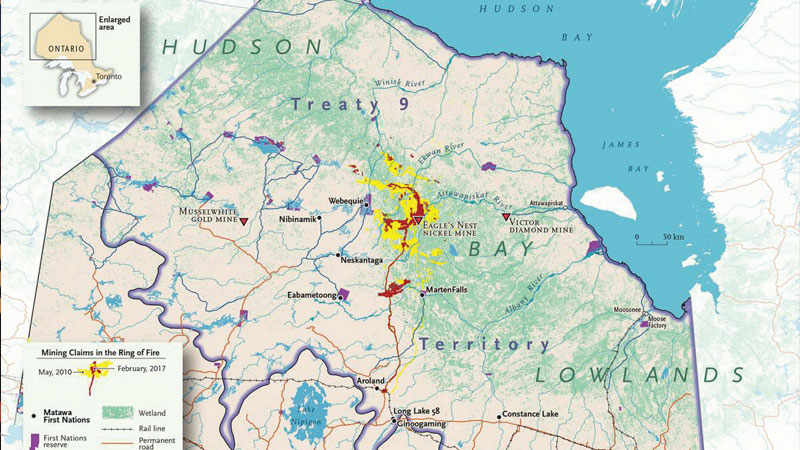Provincial cabinet minister Greg Rickford offered a “stay-tuned” response to the government’s plans to advance the construction of an access corridor to the Ring of Fire.
The Minister of Energy, Northern Development and Mines, and Indigenous Affairs was in Sudbury to reaffirm the government’s commitment to opening up the mineral deposits in the remote James Bay region. In his Jan. 23 remarks at the Procurement, Employment, Partnerships Conference in Sudbury, Rickford referred to the James Bay mineral belt as a “region of prosperity” that’s been “complicated and overburdened with bureaucracy.”
As a former board member of Noront Resources, Rickford said with $20 million already invested in the region, the Ring of Fire has been an all-talk, no-action exercise with no shovels in the ground after a decade of discussion.
Prior to the start of last year’s provincial election, funding was released for a road study and environmental assessment of the first leg of a northsouth access corridor up as far as Marten Falls First Nations, about 100 km. short of the mineral deposits. When asked when funding could be expected to be released for the environmental assessment of the second phase, Rickford said the government will deliver on this project with mining-related infrastructure announcements in the near future.
Rickford talked about forming a “coalition” of willing partners among First Nation communities and municipalities who support the construction of an access road as a “practical and pragmatic exercise” that will create jobs, generate revenue, incentivize business, and connect isolated Northern reserves. He defined that coalition as those communities that want to lead the environmental assessment processes and view the access road as a “corridor of prosperity” that will allow new infrastructure and business opportunities into the region if the mines go into development.
He praised Marten Falls and Webequie First Nations, which have shown “extraordinary leadership” in leading the environmental assessment for the proposed north-south road.
“I haven’t heard from an Indigenous leader that I’ve spoken to from the local communities most proximal (to the Ring of Fire), or businesses and municipalities down here, who’ve displayed a certain level of frustration with the ways are done. I think the people of Ontario, the people of Northern Ontario, have a right, and deserve, to approach this in a fresh and new way.”
At the same time, Rickford said he planned to reach out to two First Nation communities that are wary of the environmental consequences of industrial development in the Far North.
Rickford said he continues to have “great relationships with those communities” and expected to meet with Eabametoong Chief Elizabeth Atlookan within a week. “We see way more opportunity. I hear them. They have a high level of frustration over the past decade and a half where there’s been a lot of talk and no action.”
Rickford, a former federal natural resources minister in the Harper government, attributed that feeling to promises made by Ottawa on programming, and not kept.
He added the government remains “very eager” to revisit the controversial Far North Act, passed by the McGuinty government in 2011 without the support of Indigenous communities. “We’ll have more to say about that in the not-toodistant future.”
He offered the same answer when asked about whether talks will be restarted on the mothballed Regional Framework Agreement, the Wynne government’s planning process with area First Nations on Ring of Fire development.
On sharing resource revenues from mining and forestry operations with Indigenous people, Rickford maintained that the previous government’s May agreement with 32 northeastern Ontario communities will be honoured and expanded to other Indigenous groups and Northern municipalities.
Source: www.sootoday.com


 1-866-985-9780
1-866-985-9780








